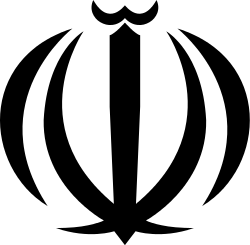Islamic Republican Party
| Islamic Republican Party | |
|---|---|
| حزب جمهوری اسلامی | |
 | |
| Historical leader |
Ruhollah Khomeini (first) Mir-Hossein Mousavi (last) |
| Founder | Mohammad Beheshti |
| Founded | 18 February 1979 |
| Dissolved | 2 May 1987 |
| Newspaper | Islamic Republican |
| International affiliation | None |
| Colours | Black |
|
Politics of Iran Political parties Elections | |
The Islamic Republican Party (Persian: حزب جمهوری اسلامی), or IRP, was a political party in Iran, formed in mid-1979 to assist the Iranian Revolution and Ayatollah Khomeini establish theocracy in Iran. It was disbanded in May 1987 due to internal conflicts.
Founders and characteristics
The party was formed just two weeks following the revolution upon the request of Ayatollah Khomeini.[1] Five cofounders of the party were Mohammad Javad Bahonar, Mohammad Beheshti, Akbar Hashemi Rafsanjani, Ali Khamenei, and Abdolkarim Mousavi-Ardabili.[1][2] Early members of the central committee of the party, in addition to founding members, were Hassan Ayat, Asadollah Badamchiyan, Abdullah Jasbi, Mir Hossein Mousavi, Habibollah Askar Oladi, Sayyed Mahmoud Kashani, Mahdi Araghi and Ali Derakhshan.[2] The party had three general secretaries: Beheshti, Bahonar and Khamenei.[2]
The party has been said to be distinguished by "its strong clerical component, its loyalty to Khomeini, its strong animosity to the liberal political movements, and its tendency to support the revolutionary organizations," such as the komiteh. Policies it supported included the state takeover of large capital enterprises, the establishment of an Islamic cultural and university system, and programs to assist the poor. [3]
These revolutionary ayatollahs originally used the party to form a monopoly over the post revolutionary theocratic Iranian state. In its struggle with civilian opponents the party made use of its ties to the Revolutionary Guards and Hezbollah
Causes of its dissolution
In the late 1980s, factionalism in the IRP intensified, the major issues being the Iran-Iraq War, whether to open up to foreign countries or remain isolated, and economic policies. Because all rival parties had been banned, the party "did almost nothing and had little incentive to."[4]
According to Ahmad Mneisi,
"While unanimous on the idea of a theological state and united under the umbrella of one party, the Islamic Republican Party (IRP), [the religious right] differed on a number of issues, such as the extent to which religion is to take hold of political life (the Velayat-e Faqih debate).[5]
Daniel Brumberg argued that it was in response to the dispute between president Ali Khamenei and popular prime Minister Mir-Hossein Mousavi, that the IRP was dissolved - the Islamic Republican Party served "as a stronghold of radical activism," supporting Mousavi. [6] However, there is another report, stated that in May 1987 it was dissolved due to internal conflicts.[2][7] And the party was disbanded upon joint proposal of Rafsanjani and then party leader Khameini on 2 May 1987 when their proposal was endorsed by Ayatollah Khomeini.[1]
Party leaders
|
|
References
- ↑ 1.0 1.1 1.2 Behrooz, Maziar (October 1994). "Factionalism in Iran under Khomeini". Middle Eastern Studies 27 (4): 597–614. doi:10.1080/00263209108700879. Retrieved 20 August 2013.
- ↑ 2.0 2.1 2.2 2.3 Asayesh, Hossein; Adlina Ab. Halim, Jayum A. Jawan and Seyedeh Nosrat Shojaei (March 2011). "Political Party in Islamic Republic of Iran: A Review". Journal of Politics and Law 4 (1). Retrieved 29 July 2013.
- ↑ Bakhash, Reign of the Ayatollahs, (1984), p. 67
- ↑ Keddie, Nikkie, Modern Iran, 2003, pp. 259-60
- ↑ Mneisi, Ahmad. 2004. The Power shift within Iran's right wing Ahram, 5 July 2004
- ↑ Brumberg, Daniel, Reinventing Khomeini : The Struggle for Reform in Iran, University of Chicago Press, 2001, p. 134
- ↑ Nikou, Semira N. "Timeline of Iran's Political Events". United States Institute of Peace. Retrieved 27 July 2013.
Further reading
- Cleveland, William L. A History of the Modern Middle East 2nd edition Oxford: Westview Press, 2000.
- Hafte tir bombing: The explosion that killed 73 high-profile IRP members.